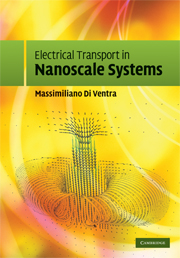Book contents
- Frontmatter
- Contents
- Preface
- 1 A primer on electron transport
- 2 Drude model, Kubo formalism and Boltzmann equation
- 3 Landauer approach
- 4 Non-equilibrium Green's function formalism
- 5 Noise
- 6 Electron-ion interaction
- 7 The micro-canonical picture of transport
- 8 Hydrodynamics of the electron liquid
- Appendices
- Appendix A A primer on second quantization
- Appendix B The quantum BBGKY hierarchy
- Appendix C The Lindblad equation
- Appendix D Ground-state Density-Functional Theory
- Appendix E Time-Dependent DFT
- Appendix F Time-Dependent Current DFT
- Appendix G Stochastic Time-Dependent Current DFT
- Appendix H Inelastic corrections to current and shot noise
- Appendix I Hydrodynamic form of the Schrödinger equation
- Appendix J Equation of motion for the stress tensor
- Appendix K Cut-off of the viscosity divergence
- Appendix L Bernoulli's equation
- References
- Index
Appendix F - Time-Dependent Current DFT
from Appendices
Published online by Cambridge University Press: 06 July 2010
- Frontmatter
- Contents
- Preface
- 1 A primer on electron transport
- 2 Drude model, Kubo formalism and Boltzmann equation
- 3 Landauer approach
- 4 Non-equilibrium Green's function formalism
- 5 Noise
- 6 Electron-ion interaction
- 7 The micro-canonical picture of transport
- 8 Hydrodynamics of the electron liquid
- Appendices
- Appendix A A primer on second quantization
- Appendix B The quantum BBGKY hierarchy
- Appendix C The Lindblad equation
- Appendix D Ground-state Density-Functional Theory
- Appendix E Time-Dependent DFT
- Appendix F Time-Dependent Current DFT
- Appendix G Stochastic Time-Dependent Current DFT
- Appendix H Inelastic corrections to current and shot noise
- Appendix I Hydrodynamic form of the Schrödinger equation
- Appendix J Equation of motion for the stress tensor
- Appendix K Cut-off of the viscosity divergence
- Appendix L Bernoulli's equation
- References
- Index
Summary
In this appendix I outline the main tenets of time-dependent current DFT (TD-CDFT). A pedagogical and extended account of this approach can be found in the book by Giuliani and Vignale (2005).
The current density as the main variable
In Appendix E I have hinted at the problem of obtaining a local representation of the exchange-correlation scalar potential Vxc (the one appearing in the Kohn–Sham equations E.4) in terms of the density. Without going into details, I just mention that the physical reason why such a representation does not exist for an inhomogeneous electron liquid is related to the strong non-local (in space) functional dependence of this potential on the density.
A way out of this problem is to realize that due to gauge invariance a time-dependent scalar potential V(r,t) can always be represented by a longitudinal vector potential A(r,t).1 We also know that the density is related to the current density via the continuity equation 1.11. Putting these two facts together, we therefore see that the response of the density operator to an external scalar potential can be expressed as the response of the current density operator to an external vector potential, i.e., we can reformulate time-dependent density-functional theory in terms of the current density instead of the density. It turns out that a local representation of the exchange-correlation vector potential in terms of the current density can be derived.
- Type
- Chapter
- Information
- Electrical Transport in Nanoscale Systems , pp. 439 - 443Publisher: Cambridge University PressPrint publication year: 2008



